The U.S. Commission of Fine Arts was established by Congress in 1910 as a permanent body to advise the federal government on matters pertaining to the arts and national symbols, and to guide the architectural development of Washington, D.C. Inspired by the City Beautiful movement and the 1893 World’s Columbian Exposition in Chicago, the creation of the Commission linked the artistic aspirations of the American nation with its nascent role as an economic, political, and cultural leader in the world. It also reflected the values of the emerging Progressive Era, which included a widespread cultural belief in the moral agency of civic art to counter the effects of industrialization on rapidly changing American cities and to improve the lives of American citizens.
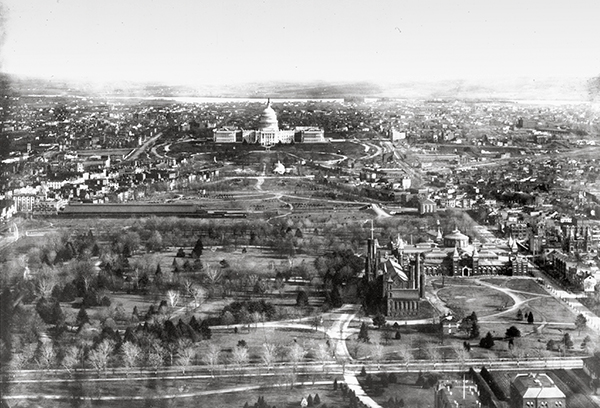
View of the Mall from the Washington Monument looking eastward, 1901. Still visible are the picturesque paths designed by Andrew Jackson Downing and the Baltimore and Potomac railway crossing the Mall at 6th Street. (Image credit: CFA)
The Monumental Design of Washington, D.C.
Two significant events at the turn of the 20th century served as precursors to the establishment of the Commission of Fine Arts. In 1900, the American Institute of Architects held its annual convention in Washington, concurrent with the centennial celebrations of the establishment of Washington as the nation’s capital. The theme of the convention was federal architecture and the improvement of the national capital; the architects passed a resolution calling for the creation of a professional design commission to oversee this effort.
In 1901, Senator James McMillan of Michigan established the Senate Park Commission and charged its appointed members—architects Daniel H. Burnham and Charles F. McKim, landscape architect Frederick Law Olmsted, Jr., and sculptor Augustus Saint-Gaudens, all major figures in the World’s Columbian Exposition—with the development and improvement of the entire park system of the District of Columbia. The Senate Park Commission applied City Beautiful precepts to the redesign of Washington’s central core. In less than a year, the commission developed an ambitious plan with several fundamental goals: to recapture the essential principles of the L’Enfant plan for the Mall; to establish and maintain design standards for this area; and to extend the District of Columbia’s park system to protect views and natural areas.
Also called the McMillan Commission, the Senate Park Commission recommended adherence to the principles of the L'Enfant Plan of 1791 and the development of a coordinated park system for the District, with particular attention to the Mall and the placement of a memorial to President Lincoln. This became the Plan of 1901 for Washington (PDF, 30MB) and the basis for the city’s development in the 20th century and beyond. Through the advocacy of Daniel Burnham and others, plans to create a federal commission to implement the ideas of the McMillan Plan were finally realized in 1910.
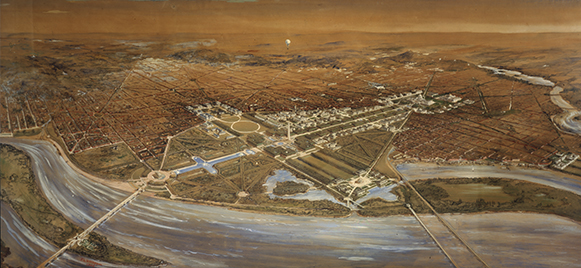
The iconic aerial view of Washington’s monumental core published in the Senate Park Commission Report, 1901. The plan incorporated reclaimed riverfront land to the south and west of the Washington Monument as extensions of L’Enfant’s public open space, The Mall, proposing an explicitly geometric organization of the heart of Washington to emphasize civic monuments. (Image credit: CFA)
Establishment of the CFA
Upon its creation by Congress on 17 May 1910, the Commission of Fine Arts was authorized to advise on the location of statues, fountains and monuments in public areas in the District of Columbia. Its thematic scope grew quickly to include public buildings erected by the federal government within the District of Columbia (Executive Order 1259), and parks, coins, and medals (Executive Order 3524). Its geographic scope evolved more slowly, in 1930 to include private buildings adjoining federal lands (Shipstead-Luce Act), and in 1950 to include all structures within the historic district in Georgetown (Old Georgetown Act).
From its inception, the Commission of Fine Arts played a significant guiding role in the design of prominent buildings and parks, through review by the panel of seven nationally prominent designers, including architects, landscape architects, and sculptors, along with distinguished laymen. Daniel Burnham was the first chairman of the CFA; Frederick Law Olmsted Jr. and Charles Moore—who had been the secretary of the McMillan Commission—were also appointed by President Taft to the CFA in 1910.
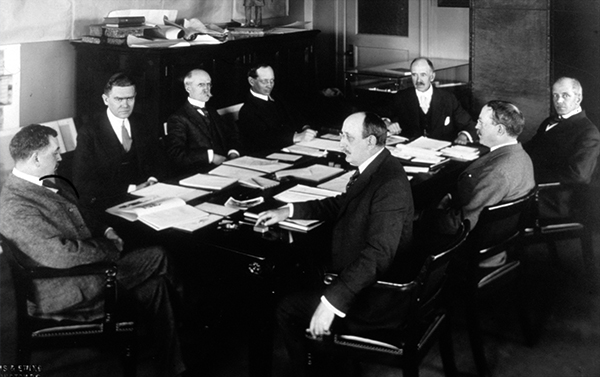
The Commission of Fine Arts, c. 1915. Clockwise from left: Charles Moore, Peirce Anderson, Edwin Blashfield, Frederick Law Olmsted Jr., Daniel Chester French (Chairman), Colonel William Harts (Secretary), Thomas Hastings, and Cass Gilbert. (Image credit: CFA)
Significant Building Projects of the Beaux-Arts Era
Under the leadership of Charles Moore, who served as the influential chairman of the CFA from 1916 to 1938, many goals of the McMillan Plan were successfully carried out, remaking the heart of Washington in a Neoclassical City Beautiful image. The design and construction of the monumental core of the capital city took decades to achieve, and the CFA oversaw the transformation of the National Mall from an eclectic landscape into a coherent space.
The first major project to be reviewed by the Commission was the Lincoln Memorial, located on the extension of the National Mall westward to the Potomac River; its completion in 1922 established a composed vista extending from the Capitol to the new memorial. As the federal government grew, the areas around this monumental core were redeveloped as locations for new government buildings, most prominently in the Federal Triangle, built from 1927 to 1940. Based in part on the Louvre and other royal complexes in Paris, the Federal Triangle is a unified, tightly composed ensemble of related buildings. In addition, the CFA worked on efforts to commemorate the fallen of World War I, guiding the design and development of American battlefield cemeteries abroad, standard military tombstones, the Arlington National Cemetery, and the Memorial Bridge connecting this cemetery to the National Mall landscape.
The CFA worked to extend the McMillan Plan vision throughout the city beyond the monumental core, using its influence to guide the establishment and design of public parks and memorials outside of the Mall precinct. The city’s many small squares, circles, and triangular parks are embellished with memorials and statuary dating from this era; the most significant project was the creation of Meridian Hill Park on 16th Street, a formal walled landscape of terraces, lawns, and sculpture.
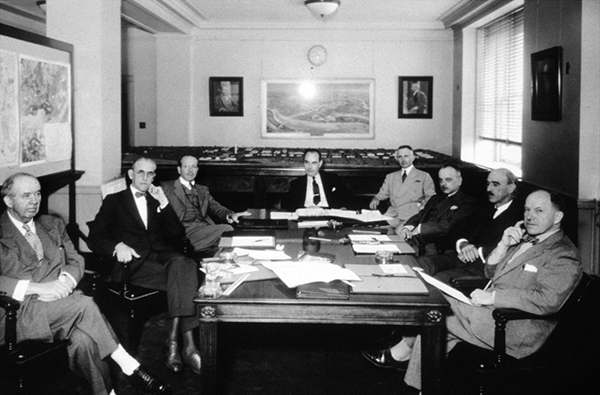
The Commission of Fine Arts in 1940. From left to right: Edward Bruce, John A. Holabird, Eugene Savage, Gilmore Clarke (Chairman), H. P. Caemmerer (Secretary), Paul Cret, William F. Lamb, and Paul Manship. (Image credit: CFA)
The CFA in the mid-20th Century
The emergence of Modernism in the 1930s began to transform architectural practice, theory, and training, eventually resulting in an evolution away from classical design as the appropriate expression for public architecture. A great debate flared over the design of the Jefferson Memorial—a Neoclassical temple by John Russell Pope—and the design was never approved by the CFA, whose professional membership had shifted its support toward Modernist design principles. The significant federal building projects of the late 1930s and early 1940s were often typified by planar, boxy reinventions of office blocks, such as the War (now State) Department Building, the General Accounting Office, and the Pentagon.
World War II brought a temporary end to major construction projects in the city, and concerns with urban renewal and transportation infrastructure dominated the post-war years. As much historic fabric of the city was demolished, new interest in the preservation of the city’s architectural heritage grew, notably with the Old Georgetown Act of 1950 and the redevelopment of Lafayette Square in the 1960s. Interestingly, there were few commemorative projects in the post-war decades, with the notable exceptions of the U.S. Marine Corps War (Iwo Jima) Memorial—statuary derived from photography—and a 1960 national competition for a memorial to President Franklin D. Roosevelt that would only be built after almost four decades and three other designs.
Large-scale development returned to Washington in the mid-1950s through the 1960s, with the development of International- and Modern-style complexes such as the Federal Center Southwest and the Kennedy Center; other civic improvements included the monumental Metro system, whose coffered station vaults recalled Imperial Roman construction.
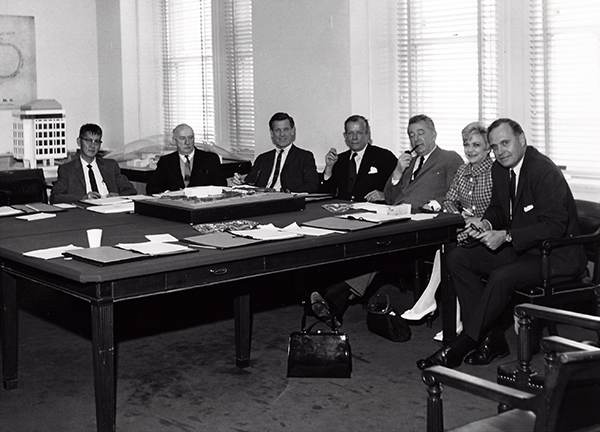
The Commission of Fine Arts in 1967. From left to right: Hideo Sasaki, Theodore Roszak, Burnham Kelly, William Walton (Chairman), Gordon Bunshaft, Aline Saarinen, and John Carl Warnecke. (Image credit: CFA)
Urbanism and Postmodernism and the CFA
The last decades of the 20th Century for the Commission of Fine Arts were dominated by the 31-year chairmanship of J. Carter Brown, director of the National Gallery of Art, and a new focus on urban design, historic preservation, and commemoration. Significant urban design projects from these decades include the rehabilitation of the National Mall for the 1976 Bicentennial, including the creation of Constitution Gardens in West Potomac Park, as well as the decades-long redevelopment of Pennsylvania Avenue and the massive completion project for the Federal Triangle, the Ronald Reagan Building.
During this period, principles of historic preservation emerged at the forefront of urban development, and the CFA was often deeply involved in controversial projects involving historic properties, such as the Old Post Office on Pennsylvania Avenue, Rhodes Tavern, and the redevelopment of the Georgetown waterfront. Compared with earlier decades, there were relatively few new government office buildings constructed in Washington in this period, but many new cultural institutions were completed, including the Hirshhorn Museum, the National Air and Space Museum, the East Building of the National Gallery of Art, the United States Holocaust Museum, and the National Museum of the American Indian.
In addition, the CFA played a central role in guiding the designs for a new phenomenon in Washington: new national war memorials proposed within West Potomac Park—including the Vietnam Veterans Memorial, the Korean War Veterans Memorial, and the World War II National Memorial—as well as the ultimate design of the President Franklin D. Roosevelt Memorial. The CFA’s advocacy of these projects was decisive in bringing about a new typology of memorialization, based in part on the formal qualities of Maya Lin’s seminal design for the Vietnam Veterans Memorial: horizontal and landscape-oriented, narrative in content, and focused on subjective experience.
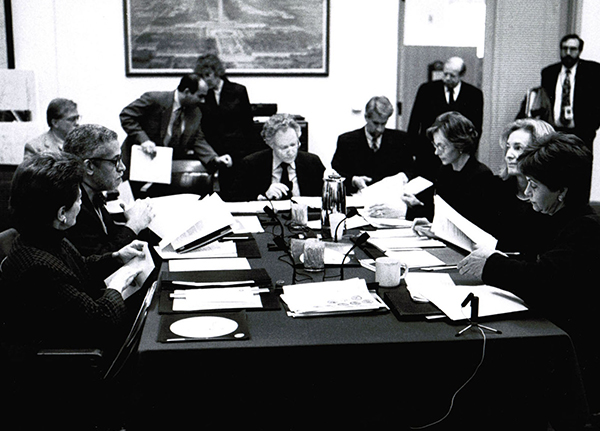
The Commission of Fine Arts in public session in 1998. From left to right: Emily Malino, Harry G. Robinson III, J. Carter Brown (Chairman), Eden Rafshoon, Carolyn Brody, and Ann Todd Free. (not pictured: Barbaralee Diamonstein-Spielvogel) (Image credit: CFA)
The CFA in the 21st Century
Security, sustainability, and technology became the most prominent design issues faced by the commission in the new century. After the terrorist attacks in Oklahoma City in 1995 and at the World Trade Center and the Pentagon in 2001, safety concerns affected urban design in Washington—from the placement and design of perimeter security barriers to street closures and increased building setbacks. In the first decade of the century, proposals for security improvements dominated the work of the CFA, and included such installations as the new Pennsylvania Avenue streetscape in front of the White House and the landscape-oriented security designs for the grounds of the Washington Monument and the Lincoln Memorial.
The first years of the new century saw the practice of sustainability—energy-conserving and environmentally responsible design and construction—gain acceptance nationally; commensurate policies, approaches, and technologies were developed and continue to evolve, all influencing building design. A new boldness in architectural expression also developed, particularly in the design of cultural institutions in the monumental core, such as the Arena Stage, the Newseum, the proposed addition to the Corcoran Gallery of Art, and the National Museum of African American History and Culture of the Smithsonian Institution.
Technological advances in design practice now allow far greater fluidity in the conceptualization and presentation of design ideas, with advances in structural and materials sciences supporting the realization of these ideas in built form. This trend is evident in the design of new memorials—such as the Pentagon 9/11 Memorial and the American Veterans Disabled for Life Memorial—in which the language of commemoration is increasingly connected to the innovative use of materials such as glass. The use of photographic imagery as a fundamental element of memorials has also been a key issue for the CFA for the design of new memorials such as the Martin Luther King, Jr. Memorial and the President Dwight D. Eisenhower Memorial.
Washington, D.C. in the 21st century has enjoyed a boom in investment and redevelopment, both in the public and private sectors. The CFA has reviewed designs for a huge program of new public buildings by the DC Government, most notably its schools and libraries. In addition, the city is experiencing a great wave of redevelopment in many sectors of the city, including the Southwest waterfront and Navy Yard, the NOMA and Mount Vernon Triangle neighborhoods, and the St. Elizabeths campus.
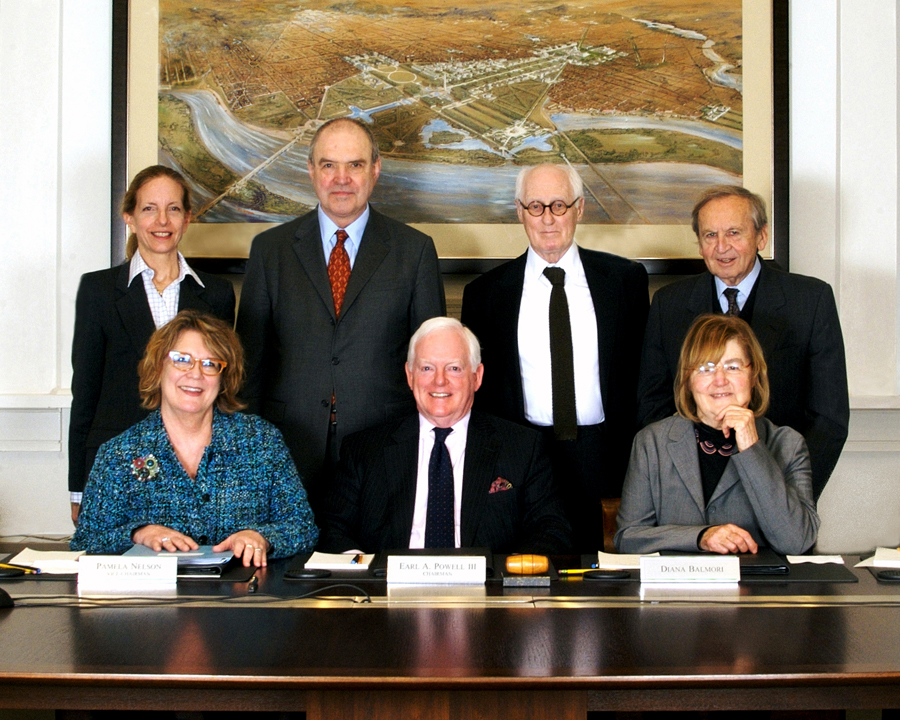
The Commission of Fine Arts in 2009. Standing from left: Elizabeth Plater-Zyberk, Witold Rybczynski, N. Michael McKinnell, and John Belle. Seated from left: Pamela Nelson (Vice Chairman), Earl A. Powell III (Chairman), and Diana Balmori. (Image credit: CFA)
For over a century, the Commission of Fine Arts has maintained the highest aspirations for urban and architectural design for this preeminent national symbol, the National Capital. As an expert panel of architects and designers, the Commission of Fine Arts continues to work in its second century to uphold design excellence in its role as a steward of the cultural heritage of Washington, D.C.
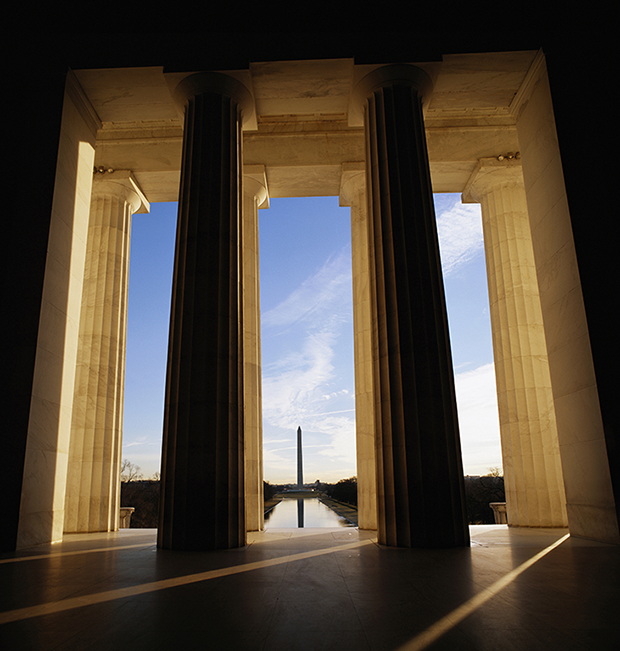
The National Mall as seen from the Lincoln Memorial, c. 2000. (Image credit: Mark Joseph / Getty Images)
